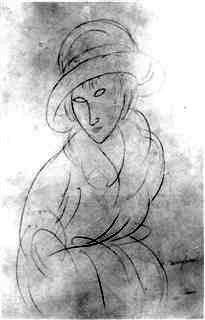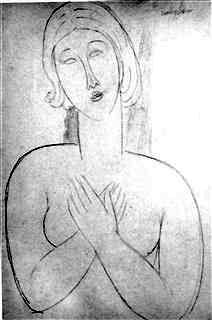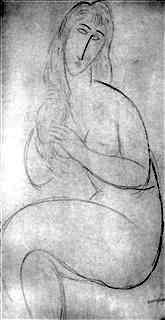 Portrait of Maud Abrantes, 1908 oil on canvas, Verso of Nude with a HatModigliani was born in Livorno, Italy, into a family of Sephardic Jews who had little money but a rich cultural life. When he arrived in Paris at the age of 22, he had had eight years of academic training behind him, and possessed a great respect for the old masters and a passionate interest in literature, especially poetry. He settled in Montmartre, entered the private Academy of Colorossi, and frequented gatherings of avant-garde artists and poets.
Portrait of Maud Abrantes, 1908 oil on canvas, Verso of Nude with a HatModigliani was born in Livorno, Italy, into a family of Sephardic Jews who had little money but a rich cultural life. When he arrived in Paris at the age of 22, he had had eight years of academic training behind him, and possessed a great respect for the old masters and a passionate interest in literature, especially poetry. He settled in Montmartre, entered the private Academy of Colorossi, and frequented gatherings of avant-garde artists and poets.
Even though he is reported to have had high esteem for Matisse and Picasso, his art, according to scholars, never had any affinity to either the Fauves or the Cubists. Modigliani admired 14th century Italian art (especially the Siena School of painting), and was interested in primitive art in general and African art in particular. African art was an avant-garde craze at the time, and it is quite probable that Modigliani saw the exhibition of African art displayed at the Trocadero in 1906. In the autumn of 1907, Modigliani met a young physician, Dr. Paul Alexander, who bought most of his early paintings. The doctor invited him to work at the artists' colony he had established on rue de Delta. They soon became friends and shared their interest in literature and poetry. Modigliani's art may be considered a personal version of expressionism. The expressionistic aspects of his work were the thematic choice of profound, often painful aspects of human life, extensive use of sharp outlines, and masterly yet intentionally strident or dissonant color combinations. He developed a highly personal style of extremely elongated, simplified forms endowed with a sense of rhythmic vitality and linear grace. Modigliani died of tuberculosis aggravated by alcoholism and drug addiction in January 1920, at the age of 37. The art dealers, who are assumed to have kept the prices of Modigliani's painting low during his lifetime, began negotiating a new price level at his funeral.
About "Portrait of Maud Abrantes" and "Nude with a Hat" in the catalogue of the Hecht Museum – The Art Collection, by Lydia Gurov
The Hidden Portrait
A Note by Ofra Guri-Rimon (2012):
 The Hidden Portrait
The Hidden Portrait
The catalogue "Museum Hecht, The Art Collection" by Lydia Gurov (ed. Ester Levinger) was published in 1999. In this catalogue nothing was written in regard to the fact that the portrait of Maud Abrantes on the verso was painted upside-down in regard to the portrait of "Nude with a Hat "on the recto of the same canvas.
Several years later, in ca. 2002, the mystery behind the painting was solved. I noticed another portrait of a woman in the area of Maud's neck and chest: a sharp eye can make out the outline of the eyes, eyebrows, nose, mouth, facial outline and a hat of a woman.
It turns out that Modigliani painted the portrait of this mysterious and hidden woman before painting the portrait of Maud Abrantes. He decided not to keep this painting and blurred it with brushes of color. But that did not suffice: he also turned the canvas over and began to paint a new portrait, this of Maud Abrantes, on the more clean and clearer part of the canvas.
My frustration at Modigliani's disregard for onlookers who are made to view one of the paintings upside-down turned into the joy of one who discovers a treasure.
Ofra Guri-Rimon, Director and Curator




